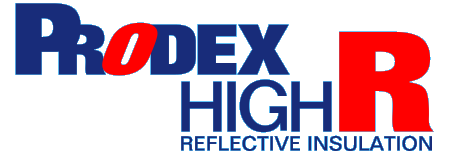

 |

|
         |
Roof Insulation
Green SavingsThe control of radiant heat transfer is the core of climate control. Every unit of radiant heat energy that is reflected away from your home in summer and every unit reflected back into your home during winter enables less use of your air conditioning/heating system, less wear on your equipment, and less money you pay in PG&E bills. Prodex HIGH R also makes an effective sound barrier inside your home. Noises such as traffic, pets and outside conversation can be reduced with proper installation. Prodex HIGH R can also reduce the noise within your home from stereos, washer/dryer, TV etc.—when installed between walls. All new homes should incorporate Prodex HIGH R into their green energy efficient house plans for both energy savings and sound reduction. Prodex HIGH R can be used as stand alone insulation, with 3/4 inch or more airspace required for the most effective performance. Or use Prodex HIGH R as a supplemental insulation along with expanded polystyrene boards (EPS), blown-in fiberglass insulation (AttiCat™), or Rmax insulation. Prodex HIGH R Radiant Barrier Unsulation Facts:
Metal Building Insulation
Prodex HIGH R insulation addresses these problems. It can reduce or eliminate condensation—delivering your metal building from corrosion and increasing the life of your metal—provides 19db sound proofing, reflects off 97% of the radiant energy and reflects back toward the inside either your cool air conditioning or warmth from your heater. Prodex HIGH R aluminum foil insulation also reflects light, increasing the ease of illuminating a metal building, while enhancing a clean, attractive appearance. Prodex HIGH R is excellent for metal building insulation! Incredible VersatilityProdex HIGH R is incredibly versatile. Use it under floors and between walls; as a house wrap under stucco siding; insulate your water heater; use as duct wrap; metal building insulation, attic isulation, and more... WEST MARIN FARMS: Check out the agricultural applications listed below-right! You can even keep your animals warm on a cold night with a Prodex HIGH R emergency blanket! Got a small
vineyard? Try a Prodex HIGH R emergency blanket for protection from a
quick frost!
How Aluminum Insulation Works:Heat Travels in Three Ways1. RADIATION (INFRARED): The primary mode of heat transfer. The sun radiates heat waves, traveling through the air in all directions. This radiation is either absorbed or reflected by the surface it comes in contact with. Your roof will absorb these infrared rays, producing heat. This heat spreads throughout your roofing material by CONDUCTION. Most materials used in building construction absorb about 90% of infrared rays. The surface of aluminum has the ability to NOT ABSORB but REFLECT 95% of the infrared rays that hit it. 2. CONDUCTION: A secondary mode of heat transfer. This is the direct heat flow through matter (molecular motion), which results from actual physical contact of one part of the same matter with another part, or on one piece of matter which touches another piece of matter. Heat is always conducted from warm to cold, and always through the shortest or easiest route. For example, place a metal pipe over a flame: the heat will begin to travel by CONDUCTION across the pipe; or place a pot of water on an electric stove: the heat will transfer by CONDUCTION from the coils to the pot, and to the water, eventually causing the water to boil (boiling through CONVECTION). 3. CONVECTION: Another secondary mode of heat transfer. This is the flow of heat within a gas (air) or liquid, caused by the flow of the material itself (mass motion). Natural or "free convection" is heat flow traveling upward, moderately sideways, but never downward. The heated elements expand, become less dense and rise. Cooler, heavier—more dense elements—enter from the side and below to replace the elements that rose. Convection may also be mechanically induced, like from a fan, which is called "forced convection." The surface of aluminum has the ability to NOT ABSORB but REFLECT 95% of the infrared rays that hit it Because aluminum foil has a low mass-per-air ratio, very little conduction can take place, allowing only 5% of infrared rays to be absorbed, and REFLECTING 95% of the infrared rays, effectively creating a RADIANT BARRIER. Reflection and emissivity by surfaces can ONLY occur in SPACE. The ideal space is 3/4 inches or more. Where there is no air space there is CONDUCTION through solids. Heat control with aluminum foil is made possible by taking advantage of its low thermal emissivity and the low thermal conductivity of air. With layered foil and air you can eliminate heat transfer by RADIATION and CONVECTION—demonstrated by the NASA space program where the space shuttles have ceramic tiles imbedded with aluminum bits which reflect heat before it can be absorbed. Also, the moon suits were made of reflective foil surfaces surrounding trapped air, enabling extensive temperature modification. Aluminum foil, with its reflective surface can block the flow of radiation. The performance of most aluminum insulation is unsurpassed for upward winter heat and it has an added protection from downward summer heat because of the absence of convection currents. Vapor/Condensation SolutionWith CONDUCTION, heat flows to cold. The under surface of a roof, when cold in winter, extracts heat out of the air with which it is in immediate contact. As a result, that air drops in temperature, condenses and turns into vapor or small particles of water. Water vapor can penetrate plaster and wood, accumulate over time and cause damage to your building. To prevent condensation, a large space is needed between the outer surface and any insulation which permits vapor to flow through. Using a separate vapor barrier, or insulation that is also a vapor barrier can effectively deal with this problem. Aluminum is impervious to water vapor and with the trapped air space of Prodex HIGH R, is immune to vapor condensation. R-Value TestingR Factor, or R-value, is RESISTANCE TO HEAT FLOW. R-value is not used to rate a materials ability to resist RADIANT heat. Insulation is rated by its ability to resist both conductive and convective heat flow in R-value units. There are currently two methods used by laboratories to measure thermal values: guarded hot plate and hot box methods. Neither technique simulates heat flow through insulation in actual everyday usage (the RADIATION of CONVECTION flow). Therefore, R-value cannot be used exclusively to compare different types of insulation because each type has properties that vary due to ventilation and resistance to moisture—which can reduce insulation effectiveness. Thermal conductivity measurements made in the dry-state of a lab won't match the performance of those same insulations under real field conditions. Most mass-type insulation materials become conductors of heat when the relative humidity increases because of moisture absorbed by the insulator. With aluminum insulation there is NO MOISTURE PROBLEM. Aluminum foil is one of the few insulating materials that is NOT AFFECTED BY HUMIDITY so its insulating value remains unchanged from a dry-state to high humidity. Prodex HIGH R Meets or Exceeds Building Codes
|
|
Web site designed by NetResult Web Marketing |
|